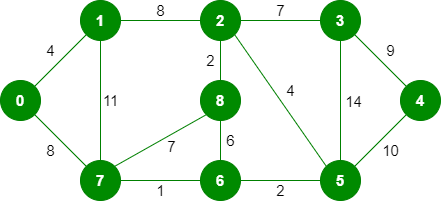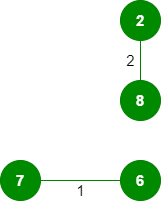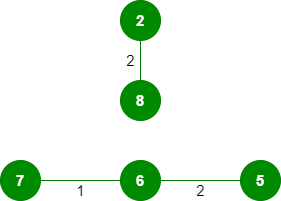什么是最小生成树?
给定一个连通图和无向图,该图的生成树是一个子图,它是一棵树并将所有顶点连接在一起。单个图可以有许多不同的生成树。加权、连通、无向图的最小生成树 (MST)或最小权重生成树是权重小于或等于其他所有生成树权重的生成树。生成树的权重是赋予生成树每条边的权重之和。
最小生成树有多少条边?
最小生成树有 (V – 1) 条边,其中 V 是给定图中的顶点数。
最小生成树有哪些应用?
请参阅此处了解 MST 的应用。
以下是使用 Kruskal 算法查找 MST 的步骤
1. Sort all the edges in non-decreasing order of their weight.
2. Pick the smallest edge. Check if it forms a cycle with the spanning tree formed so far. If cycle is not formed, include this edge. Else, discard it.
3. Repeat step#2 until there are (V-1) edges in the spanning tree.
第 2 步使用 Union-Find 算法来检测循环。因此,我们建议先阅读以下帖子。
联合查找算法 |设置 1(检测图中的循环)
联合查找算法 |第 2 组(按等级和路径压缩合并)
该算法是一种贪心算法。贪婪的选择是选择在目前构造的 MST 中不会导致循环的最小权重边。让我们通过一个例子来理解它:考虑下面的输入图。

该图包含 9 个顶点和 14 条边。因此,形成的最小生成树将具有 (9 – 1) = 8 条边。
After sorting:
Weight Src Dest
1 7 6
2 8 2
2 6 5
4 0 1
4 2 5
6 8 6
7 2 3
7 7 8
8 0 7
8 1 2
9 3 4
10 5 4
11 1 7
14 3 5现在从边的排序列表中一一选择所有边
1.拾取边 7-6:不形成环,包括它。

2.拾取边 8-2:不形成环,包括它。

3.拾取边 6-5:不形成循环,包括它。

4.拾取边 0-1:不形成循环,包括它。

5.拾取边 2-5:不形成循环,包括它。

6.选取边 8-6:由于将这条边包含在循环中,因此将其丢弃。
7.拾取边2-3:不形成循环,包括它。

8.选取边 7-8:由于将这条边包含在循环中,因此将其丢弃。
9.拾取边 0-7:不形成循环,包括它。

10.选取边 1-2:由于将这条边包含在循环中,因此将其丢弃。
11.拾取边3-4:不形成循环,包括它。

由于包含的边数等于 (V – 1),算法到此停止。
下面是上述想法的实现:
C
// C program for Kruskal's algorithm to find Minimum
// Spanning Tree of a given connected, undirected and
// weighted graph
#include
#include
#include
// a structure to represent a weighted edge in graph
struct Edge {
int src, dest, weight;
};
// a structure to represent a connected, undirected
// and weighted graph
struct Graph {
// V-> Number of vertices, E-> Number of edges
int V, E;
// graph is represented as an array of edges.
// Since the graph is undirected, the edge
// from src to dest is also edge from dest
// to src. Both are counted as 1 edge here.
struct Edge* edge;
};
// Creates a graph with V vertices and E edges
struct Graph* createGraph(int V, int E)
{
struct Graph* graph = (struct Graph*)(malloc(sizeof(struct Graph)));
graph->V = V;
graph->E = E;
graph->edge = (struct Edge*)malloc(sizeof( struct Edge)*E);
return graph;
}
// A structure to represent a subset for union-find
struct subset {
int parent;
int rank;
};
// A utility function to find set of an element i
// (uses path compression technique)
int find(struct subset subsets[], int i)
{
// find root and make root as parent of i
// (path compression)
if (subsets[i].parent != i)
subsets[i].parent
= find(subsets, subsets[i].parent);
return subsets[i].parent;
}
// A function that does union of two sets of x and y
// (uses union by rank)
void Union(struct subset subsets[], int x, int y)
{
int xroot = find(subsets, x);
int yroot = find(subsets, y);
// Attach smaller rank tree under root of high
// rank tree (Union by Rank)
if (subsets[xroot].rank < subsets[yroot].rank)
subsets[xroot].parent = yroot;
else if (subsets[xroot].rank > subsets[yroot].rank)
subsets[yroot].parent = xroot;
// If ranks are same, then make one as root and
// increment its rank by one
else
{
subsets[yroot].parent = xroot;
subsets[xroot].rank++;
}
}
// Compare two edges according to their weights.
// Used in qsort() for sorting an array of edges
int myComp(const void* a, const void* b)
{
struct Edge* a1 = (struct Edge*)a;
struct Edge* b1 = (struct Edge*)b;
return a1->weight > b1->weight;
}
// The main function to construct MST using Kruskal's
// algorithm
void KruskalMST(struct Graph* graph)
{
int V = graph->V;
struct Edge
result[V]; // Tnis will store the resultant MST
int e = 0; // An index variable, used for result[]
int i = 0; // An index variable, used for sorted edges
// Step 1: Sort all the edges in non-decreasing
// order of their weight. If we are not allowed to
// change the given graph, we can create a copy of
// array of edges
qsort(graph->edge, graph->E, sizeof(graph->edge[0]),
myComp);
// Allocate memory for creating V ssubsets
struct subset* subsets
= (struct subset*)malloc(V * sizeof(struct subset));
// Create V subsets with single elements
for (int v = 0; v < V; ++v) {
subsets[v].parent = v;
subsets[v].rank = 0;
}
// Number of edges to be taken is equal to V-1
while (e < V - 1 && i < graph->E) {
// Step 2: Pick the smallest edge. And increment
// the index for next iteration
struct Edge next_edge = graph->edge[i++];
int x = find(subsets, next_edge.src);
int y = find(subsets, next_edge.dest);
// If including this edge does't cause cycle,
// include it in result and increment the index
// of result for next edge
if (x != y) {
result[e++] = next_edge;
Union(subsets, x, y);
}
// Else discard the next_edge
}
// print the contents of result[] to display the
// built MST
printf(
"Following are the edges in the constructed MST\n");
int minimumCost = 0;
for (i = 0; i < e; ++i)
{
printf("%d -- %d == %d\n", result[i].src,
result[i].dest, result[i].weight);
minimumCost += result[i].weight;
}
printf("Minimum Cost Spanning tree : %d",minimumCost);
return;
}
// Driver program to test above functions
int main()
{
/* Let us create following weighted graph
10
0--------1
| \ |
6| 5\ |15
| \ |
2--------3
4 */
int V = 4; // Number of vertices in graph
int E = 5; // Number of edges in graph
struct Graph* graph = createGraph(V, E);
// add edge 0-1
graph->edge[0].src = 0;
graph->edge[0].dest = 1;
graph->edge[0].weight = 10;
// add edge 0-2
graph->edge[1].src = 0;
graph->edge[1].dest = 2;
graph->edge[1].weight = 6;
// add edge 0-3
graph->edge[2].src = 0;
graph->edge[2].dest = 3;
graph->edge[2].weight = 5;
// add edge 1-3
graph->edge[3].src = 1;
graph->edge[3].dest = 3;
graph->edge[3].weight = 15;
// add edge 2-3
graph->edge[4].src = 2;
graph->edge[4].dest = 3;
graph->edge[4].weight = 4;
KruskalMST(graph);
return 0;
} Java
// Java program for Kruskal's algorithm to
// find Minimum Spanning Tree of a given
//connected, undirected and weighted graph
import java.util.*;
import java.lang.*;
import java.io.*;
class Graph {
// A class to represent a graph edge
class Edge implements Comparable
{
int src, dest, weight;
// Comparator function used for
// sorting edgesbased on their weight
public int compareTo(Edge compareEdge)
{
return this.weight - compareEdge.weight;
}
};
// A class to represent a subset for
// union-find
class subset
{
int parent, rank;
};
int V, E; // V-> no. of vertices & E->no.of edges
Edge edge[]; // collection of all edges
// Creates a graph with V vertices and E edges
Graph(int v, int e)
{
V = v;
E = e;
edge = new Edge[E];
for (int i = 0; i < e; ++i)
edge[i] = new Edge();
}
// A utility function to find set of an
// element i (uses path compression technique)
int find(subset subsets[], int i)
{
// find root and make root as parent of i
// (path compression)
if (subsets[i].parent != i)
subsets[i].parent
= find(subsets, subsets[i].parent);
return subsets[i].parent;
}
// A function that does union of two sets
// of x and y (uses union by rank)
void Union(subset subsets[], int x, int y)
{
int xroot = find(subsets, x);
int yroot = find(subsets, y);
// Attach smaller rank tree under root
// of high rank tree (Union by Rank)
if (subsets[xroot].rank
< subsets[yroot].rank)
subsets[xroot].parent = yroot;
else if (subsets[xroot].rank
> subsets[yroot].rank)
subsets[yroot].parent = xroot;
// If ranks are same, then make one as
// root and increment its rank by one
else {
subsets[yroot].parent = xroot;
subsets[xroot].rank++;
}
}
// The main function to construct MST using Kruskal's
// algorithm
void KruskalMST()
{
// Tnis will store the resultant MST
Edge result[] = new Edge[V];
// An index variable, used for result[]
int e = 0;
// An index variable, used for sorted edges
int i = 0;
for (i = 0; i < V; ++i)
result[i] = new Edge();
// Step 1: Sort all the edges in non-decreasing
// order of their weight. If we are not allowed to
// change the given graph, we can create a copy of
// array of edges
Arrays.sort(edge);
// Allocate memory for creating V ssubsets
subset subsets[] = new subset[V];
for (i = 0; i < V; ++i)
subsets[i] = new subset();
// Create V subsets with single elements
for (int v = 0; v < V; ++v)
{
subsets[v].parent = v;
subsets[v].rank = 0;
}
i = 0; // Index used to pick next edge
// Number of edges to be taken is equal to V-1
while (e < V - 1)
{
// Step 2: Pick the smallest edge. And increment
// the index for next iteration
Edge next_edge = edge[i++];
int x = find(subsets, next_edge.src);
int y = find(subsets, next_edge.dest);
// If including this edge does't cause cycle,
// include it in result and increment the index
// of result for next edge
if (x != y) {
result[e++] = next_edge;
Union(subsets, x, y);
}
// Else discard the next_edge
}
// print the contents of result[] to display
// the built MST
System.out.println("Following are the edges in "
+ "the constructed MST");
int minimumCost = 0;
for (i = 0; i < e; ++i)
{
System.out.println(result[i].src + " -- "
+ result[i].dest
+ " == " + result[i].weight);
minimumCost += result[i].weight;
}
System.out.println("Minimum Cost Spanning Tree "
+ minimumCost);
}
// Driver Code
public static void main(String[] args)
{
/* Let us create following weighted graph
10
0--------1
| \ |
6| 5\ |15
| \ |
2--------3
4 */
int V = 4; // Number of vertices in graph
int E = 5; // Number of edges in graph
Graph graph = new Graph(V, E);
// add edge 0-1
graph.edge[0].src = 0;
graph.edge[0].dest = 1;
graph.edge[0].weight = 10;
// add edge 0-2
graph.edge[1].src = 0;
graph.edge[1].dest = 2;
graph.edge[1].weight = 6;
// add edge 0-3
graph.edge[2].src = 0;
graph.edge[2].dest = 3;
graph.edge[2].weight = 5;
// add edge 1-3
graph.edge[3].src = 1;
graph.edge[3].dest = 3;
graph.edge[3].weight = 15;
// add edge 2-3
graph.edge[4].src = 2;
graph.edge[4].dest = 3;
graph.edge[4].weight = 4;
// Function call
graph.KruskalMST();
}
}
// This code is contributed by Aakash Hasija Python
# Python program for Kruskal's algorithm to find
# Minimum Spanning Tree of a given connected,
# undirected and weighted graph
from collections import defaultdict
# Class to represent a graph
class Graph:
def __init__(self, vertices):
self.V = vertices # No. of vertices
self.graph = [] # default dictionary
# to store graph
# function to add an edge to graph
def addEdge(self, u, v, w):
self.graph.append([u, v, w])
# A utility function to find set of an element i
# (uses path compression technique)
def find(self, parent, i):
if parent[i] == i:
return i
return self.find(parent, parent[i])
# A function that does union of two sets of x and y
# (uses union by rank)
def union(self, parent, rank, x, y):
xroot = self.find(parent, x)
yroot = self.find(parent, y)
# Attach smaller rank tree under root of
# high rank tree (Union by Rank)
if rank[xroot] < rank[yroot]:
parent[xroot] = yroot
elif rank[xroot] > rank[yroot]:
parent[yroot] = xroot
# If ranks are same, then make one as root
# and increment its rank by one
else:
parent[yroot] = xroot
rank[xroot] += 1
# The main function to construct MST using Kruskal's
# algorithm
def KruskalMST(self):
result = [] # This will store the resultant MST
# An index variable, used for sorted edges
i = 0
# An index variable, used for result[]
e = 0
# Step 1: Sort all the edges in
# non-decreasing order of their
# weight. If we are not allowed to change the
# given graph, we can create a copy of graph
self.graph = sorted(self.graph,
key=lambda item: item[2])
parent = []
rank = []
# Create V subsets with single elements
for node in range(self.V):
parent.append(node)
rank.append(0)
# Number of edges to be taken is equal to V-1
while e < self.V - 1:
# Step 2: Pick the smallest edge and increment
# the index for next iteration
u, v, w = self.graph[i]
i = i + 1
x = self.find(parent, u)
y = self.find(parent, v)
# If including this edge does't
# cause cycle, include it in result
# and increment the indexof result
# for next edge
if x != y:
e = e + 1
result.append([u, v, w])
self.union(parent, rank, x, y)
# Else discard the edge
minimumCost = 0
print ("Edges in the constructed MST")
for u, v, weight in result:
minimumCost += weight
print("%d -- %d == %d" % (u, v, weight))
print("Minimum Spanning Tree" , minimumCost)
# Driver code
g = Graph(4)
g.addEdge(0, 1, 10)
g.addEdge(0, 2, 6)
g.addEdge(0, 3, 5)
g.addEdge(1, 3, 15)
g.addEdge(2, 3, 4)
# Function call
g.KruskalMST()
# This code is contributed by Neelam YadavC#
// C# Code for above approach
using System;
class Graph {
// A class to represent a graph edge
class Edge : IComparable {
public int src, dest, weight;
// Comparator function used for sorting edges
// based on their weight
public int CompareTo(Edge compareEdge)
{
return this.weight
- compareEdge.weight;
}
}
// A class to represent
// a subset for union-find
public class subset
{
public int parent, rank;
};
int V, E; // V-> no. of vertices & E->no.of edges
Edge[] edge; // collection of all edges
// Creates a graph with V vertices and E edges
Graph(int v, int e)
{
V = v;
E = e;
edge = new Edge[E];
for (int i = 0; i < e; ++i)
edge[i] = new Edge();
}
// A utility function to find set of an element i
// (uses path compression technique)
int find(subset[] subsets, int i)
{
// find root and make root as
// parent of i (path compression)
if (subsets[i].parent != i)
subsets[i].parent
= find(subsets, subsets[i].parent);
return subsets[i].parent;
}
// A function that does union of
// two sets of x and y (uses union by rank)
void Union(subset[] subsets, int x, int y)
{
int xroot = find(subsets, x);
int yroot = find(subsets, y);
// Attach smaller rank tree under root of
// high rank tree (Union by Rank)
if (subsets[xroot].rank < subsets[yroot].rank)
subsets[xroot].parent = yroot;
else if (subsets[xroot].rank > subsets[yroot].rank)
subsets[yroot].parent = xroot;
// If ranks are same, then make one as root
// and increment its rank by one
else {
subsets[yroot].parent = xroot;
subsets[xroot].rank++;
}
}
// The main function to construct MST
// using Kruskal's algorithm
void KruskalMST()
{
// This will store the
// resultant MST
Edge[] result = new Edge[V];
int e = 0; // An index variable, used for result[]
int i
= 0; // An index variable, used for sorted edges
for (i = 0; i < V; ++i)
result[i] = new Edge();
// Step 1: Sort all the edges in non-decreasing
// order of their weight. If we are not allowed
// to change the given graph, we can create
// a copy of array of edges
Array.Sort(edge);
// Allocate memory for creating V ssubsets
subset[] subsets = new subset[V];
for (i = 0; i < V; ++i)
subsets[i] = new subset();
// Create V subsets with single elements
for (int v = 0; v < V; ++v) {
subsets[v].parent = v;
subsets[v].rank = 0;
}
i = 0; // Index used to pick next edge
// Number of edges to be taken is equal to V-1
while (e < V - 1)
{
// Step 2: Pick the smallest edge. And increment
// the index for next iteration
Edge next_edge = new Edge();
next_edge = edge[i++];
int x = find(subsets, next_edge.src);
int y = find(subsets, next_edge.dest);
// If including this edge does't cause cycle,
// include it in result and increment the index
// of result for next edge
if (x != y) {
result[e++] = next_edge;
Union(subsets, x, y);
}
// Else discard the next_edge
}
// print the contents of result[] to display
// the built MST
Console.WriteLine("Following are the edges in "
+ "the constructed MST");
int minimumCost = 0
for (i = 0; i < e; ++i)
{
Console.WriteLine(result[i].src + " -- "
+ result[i].dest
+ " == " + result[i].weight);
minimumCost += result[i].weight;
}
Console.WriteLine("Minimum Cost Spanning Tree"
+ minimumCost);
Console.ReadLine();
}
// Driver Code
public static void Main(String[] args)
{
/* Let us create following weighted graph
10
0--------1
| \ |
6| 5\ |15
| \ |
2--------3
4 */
int V = 4; // Number of vertices in graph
int E = 5; // Number of edges in graph
Graph graph = new Graph(V, E);
// add edge 0-1
graph.edge[0].src = 0;
graph.edge[0].dest = 1;
graph.edge[0].weight = 10;
// add edge 0-2
graph.edge[1].src = 0;
graph.edge[1].dest = 2;
graph.edge[1].weight = 6;
// add edge 0-3
graph.edge[2].src = 0;
graph.edge[2].dest = 3;
graph.edge[2].weight = 5;
// add edge 1-3
graph.edge[3].src = 1;
graph.edge[3].dest = 3;
graph.edge[3].weight = 15;
// add edge 2-3
graph.edge[4].src = 2;
graph.edge[4].dest = 3;
graph.edge[4].weight = 4;
// Function call
graph.KruskalMST();
}
}
// This code is contributed by Aakash Hasija C++
// C++ program for Kruskal's algorithm
// to find Minimum Spanning Tree of a
// given connected, undirected and weighted
// graph
#include
using namespace std;
// a structure to represent a
// weighted edge in graph
class Edge {
public:
int src, dest, weight;
};
// a structure to represent a connected,
// undirected and weighted graph
class Graph {
public:
// V-> Number of vertices, E-> Number of edges
int V, E;
// graph is represented as an array of edges.
// Since the graph is undirected, the edge
// from src to dest is also edge from dest
// to src. Both are counted as 1 edge here.
Edge* edge;
};
// Creates a graph with V vertices and E edges
Graph* createGraph(int V, int E)
{
Graph* graph = new Graph;
graph->V = V;
graph->E = E;
graph->edge = new Edge[E];
return graph;
}
// A structure to represent a subset for union-find
class subset {
public:
int parent;
int rank;
};
// A utility function to find set of an element i
// (uses path compression technique)
int find(subset subsets[], int i)
{
// find root and make root as parent of i
// (path compression)
if (subsets[i].parent != i)
subsets[i].parent
= find(subsets, subsets[i].parent);
return subsets[i].parent;
}
// A function that does union of two sets of x and y
// (uses union by rank)
void Union(subset subsets[], int x, int y)
{
int xroot = find(subsets, x);
int yroot = find(subsets, y);
// Attach smaller rank tree under root of high
// rank tree (Union by Rank)
if (subsets[xroot].rank < subsets[yroot].rank)
subsets[xroot].parent = yroot;
else if (subsets[xroot].rank > subsets[yroot].rank)
subsets[yroot].parent = xroot;
// If ranks are same, then make one as root and
// increment its rank by one
else {
subsets[yroot].parent = xroot;
subsets[xroot].rank++;
}
}
// Compare two edges according to their weights.
// Used in qsort() for sorting an array of edges
int myComp(const void* a, const void* b)
{
Edge* a1 = (Edge*)a;
Edge* b1 = (Edge*)b;
return a1->weight > b1->weight;
}
// The main function to construct MST using Kruskal's
// algorithm
void KruskalMST(Graph* graph)
{
int V = graph->V;
Edge result[V]; // Tnis will store the resultant MST
int e = 0; // An index variable, used for result[]
int i = 0; // An index variable, used for sorted edges
// Step 1: Sort all the edges in non-decreasing
// order of their weight. If we are not allowed to
// change the given graph, we can create a copy of
// array of edges
qsort(graph->edge, graph->E, sizeof(graph->edge[0]),
myComp);
// Allocate memory for creating V ssubsets
subset* subsets = new subset[(V * sizeof(subset))];
// Create V subsets with single elements
for (int v = 0; v < V; ++v)
{
subsets[v].parent = v;
subsets[v].rank = 0;
}
// Number of edges to be taken is equal to V-1
while (e < V - 1 && i < graph->E)
{
// Step 2: Pick the smallest edge. And increment
// the index for next iteration
Edge next_edge = graph->edge[i++];
int x = find(subsets, next_edge.src);
int y = find(subsets, next_edge.dest);
// If including this edge does't cause cycle,
// include it in result and increment the index
// of result for next edge
if (x != y) {
result[e++] = next_edge;
Union(subsets, x, y);
}
// Else discard the next_edge
}
// print the contents of result[] to display the
// built MST
cout << "Following are the edges in the constructed "
"MST\n";
int minimumCost = 0;
for (i = 0; i < e; ++i)
{
cout << result[i].src << " -- " << result[i].dest
<< " == " << result[i].weight << endl;
minimumCost = minimumCost + result[i].weight;
}
// return;
cout << "Minimum Cost Spanning Tree: " << minimumCost
<< endl;
}
// Driver code
int main()
{
/* Let us create following weighted graph
10
0--------1
| \ |
6| 5\ |15
| \ |
2--------3
4 */
int V = 4; // Number of vertices in graph
int E = 5; // Number of edges in graph
Graph* graph = createGraph(V, E);
// add edge 0-1
graph->edge[0].src = 0;
graph->edge[0].dest = 1;
graph->edge[0].weight = 10;
// add edge 0-2
graph->edge[1].src = 0;
graph->edge[1].dest = 2;
graph->edge[1].weight = 6;
// add edge 0-3
graph->edge[2].src = 0;
graph->edge[2].dest = 3;
graph->edge[2].weight = 5;
// add edge 1-3
graph->edge[3].src = 1;
graph->edge[3].dest = 3;
graph->edge[3].weight = 15;
// add edge 2-3
graph->edge[4].src = 2;
graph->edge[4].dest = 3;
graph->edge[4].weight = 4;
// Function call
KruskalMST(graph);
return 0;
}
// This code is contributed by rathbhupendra Following are the edges in the constructed MST
2 -- 3 == 4
0 -- 3 == 5
0 -- 1 == 10
Minimum Cost Spanning Tree: 19时间复杂度: O(ElogE) 或 O(ElogV)。边的排序需要 O(ELogE) 时间。排序后,我们遍历所有边并应用 find-union 算法。 find 和 union 操作最多需要 O(LogV) 时间。所以整体复杂度是 O(ELogE + ELogV) 时间。 E 的值最多可以是 O(V 2 ),因此 O(LogV) 与 O(LogE) 相同。因此,整体时间复杂度为 O(ElogE) 或 O(ElogV)
如果您希望与专家一起参加现场课程,请参阅DSA 现场工作专业课程和学生竞争性编程现场课程。